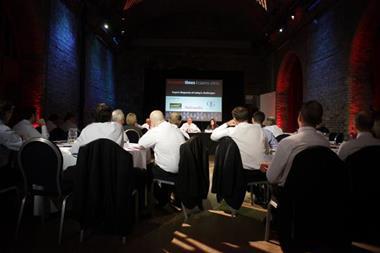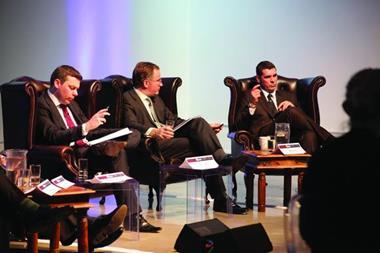When it comes to customer service, good communication is vital. Yet too much communication with the policyholder just causes confusion. Do brokers and insurers need to take a step back?
When it comes to customer service and levels of communication, a delicate balancing act is needed: clients demand not too little and not too much. This was the message from Insurance Times’s latest Claims Clinic, which took place last week. The clinic centred on the difficult issue of providing good customer service while ensuring efficient supply chains and controlling indemnity spend. Technological advances are also proving to be both a help and a hindrance to the industry.
Held at Vinopolis on London’s South Bank, the event was chaired by Insurance Times deputy editor David Blackman. The panel comprised Towergate Underwriting claims director Simon Gifford, Fortis head of operations for household and travel claims Gary Lobb, Richard Turner of the Chartered Institute of Loss Adjusters (CILA), Scalepoint director of sales Marcella Flood, and Comet national sales manager Sue Cuthbert.
Fortis’s Lobb highlighted issues resulting from what he saw as the increased involvement of brokers in the claims process. He said that although he understood why brokers want to get involved, he “would rather work with the brokers to understand what they are trying to do, and give them some comfort about what we are doing to make sure the claim is being serviced properly”.
Lobb said he believes that brokers are getting involved in the claims process in order to police it, which is causing more harm than good to customer relations. “There is a myth out there in certain circles that lots of contact with the policyholder is always a good thing during the claims process, but I have found that it causes unnecessary confusion,” he said.
A toe in the process
Towergate’s Gifford said brokers did not wish to become more involved in the claims supply chain than they had to. “It’s no surprise to me to hear that brokers are trying to get a toe into the claims process. But I don’t think there is the same desire to get a shoe in on the supply chain or try to drive any revenue income up.”
He commented that the key to improving the current situation is to ensure that the “customer service ethos” is unchanged between brokers and claims departments.
From a loss adjuster’s perspective, Turner welcomed broker involvement. But he said that project management – what he described as “proper ownership” of the claims process – is the crucial link to achieving a good balance between good customer service and controlling indemnity costs.
“Service is something that is at the forefront of all our minds. If there is good communication between the broker, loss adjuster and the insurer, that can only serve to help deliver the required outcome quickly and effectively,” he said.
The effect of the economic downturn has impacted heavily on the industry’s ability to find a balanced value-for-money deal for both clients and brokers, he added.
“Customers now want value. They are not going to accept anything but the best service and the right offer. That’s even more the case now, because if they’re not reducing or avoiding cover altogether because of economic woes, when they have a claim, they are going to make sure they get value from it.”
Cuthbert said economic belt-tightening means that clients are considering their replacement purchases more carefully than ever in order to ensure value. She cited research showing it takes an average of 72 days for someone to choose a television; it is these sorts of time frame that frustrate insurers, causing conflict with clients.
But she warned claims departments to steer clear of discord. She said: “With the economic pressures of today for most families, the decision for a customer to stay with that chosen insurer is very much based on how their claims experience has gone.”
Stand by your product
Value-for-money in pricing is not only an issue for insurance companies and replacement services, but also for loss adjusters. Turner said customers are keen to find the best possible deal when their claim is processed. “Traditionally, loss adjusting has been dealt with on time and expense, or fixed-fee, basis. But clients are now looking for companies to stand behind their products. We now have capped indemnity, where pricing is based on controlling the whole cost, including indemnity on a fixed basis.”
Personal household insurance, or “lifestyle protection” as Gifford dubbed it, is one of the highest volume areas of claims, attracting innovation and a sometimes dizzying pace of change.
In consequence, customers can have a very mixed experience, with service ranging from the very poor to the very good. Gifford said: “I think service varies considerably from carrier to carrier from the different view we have. There is a rush to communicate with customers, which simply creates communication for the sake of it.”
Lobb agreed, adding that customers don’t want to hear from insurers unless they are adding something valuable to the process. “There are vastly different levels of service out there from a claims perspective and from the suppliers. You have to have good customer service to remain efficient. But efficiency means keeping touches to the claim to a minimum.”
Tech changes
All five panellists agreed that technology will dramatically change customer relations in the claims market landscape within the next two to three years. Gifford said: “It will allow the scoping and validation of the claims process to be done very quickly, in a real-time way. It will allow insurers to use expertise at the validation stage of the claim.”
Turner said technological change would enable loss adjusters to improve customer service in the field by updating client appointments, checking policy wording and offering printed-letter-quality typed correspondence, immediately advising clients of the claims process.
Technological advances have discouraged customers from opting for replacement goods to settle a claim – rather than, say, a cash settlement. Cuthbert says customers are increasingly savvy and well researched. As a result, they know what they want.
But, she pointed out, technology is advancing so fast that the specifications of a laptop being developed today are different from those now on the market. It is this lightning-fast pace that Flood noted causes many client-relation issues, because customers do not understand the original product cost is often no longer relevant.
She said: “It’s difficult to show the customer that we do understand the value of the product and that what we are offering is a fair replacement.”
On balance
Lastly, the panel considered insurers’ reluctance to write business in high-risk areas. Turner said the Cumbrian floods of November 2009 brought this issue to the surface, creating a fear of significant uninsured losses for that locality. But, as Gifford noted: “There seems to be a rise in non-standard policies, and this presents an opportunity for those sophisticated enough to write non-standard at profit.”
Mismanagement of customer service ultimately increases costs for insurers because they need to employ people to deal with increased queries and contact, according to Lobb.
But Flood argued: “It’s a matter of finding a balance. There is no one-size-fits-all answer. Finding the right balance depends on the insurer. Different types of insurers have different policies, and each claim will have a different type of feel for the customer.”
Achieving positive, effective, and efficient customer service is both a problem and a potential solution for the insurance industry. Value-driven personal lines customers needing specialist care are increasingly sandwiched between indemnity-conscious claims departments and brokers with a desire to both acquire new clients and retain and sell to existing clients.
But achieving the right balance will bring rewards, Gifford said: “An insurer who has the ability to help on all three things is an insurer that we will continue to work with and one who will have a very prosperous relationship with brokers.” IT
Hosted by comedian and actor Tom Allen, 34 Gold, 23 Silver and 22 Bronze awards were handed out across an amazing 34 categories recognising brilliance and innovation right across the breadth of UK general insurance.














































No comments yet